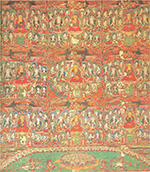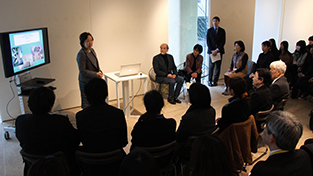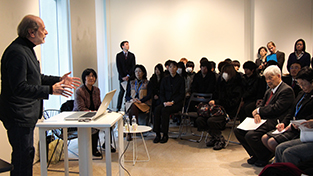- HOME >
- NEWS >
- Jacques Giès Gives a Josai University 50th Anniversary Special Lecture: “Integration of Buddhism in China and Japan”


Josai University Educational Corporation (Chancellor Noriko Mizuta) celebrated its 50th anniversary with a special lecture by Jacques Giès in the Tokyo Kioicho Campus 3rd Building on January 20, 2016. Dr. Giès—a former Director of the Guimet National Museum of Asian Arts in France—spoke about the “Integration of Buddhism in China and Japan.”
Dr. Giès is a French expert in Buddhist art and Chinese studies. He also possesses a wide range of knowledge through his deep connections to museum management and cultural administration. He studied art history at the University of Paris (the Sorbonne) and Chinese language and civilization at the INALCO (National Institute for Oriental Languages and Civilizations). After receiving his doctorates, he went on to teach for many years at both universities, as well as at the École du Louvre. He also held many other positions, including Curator for the Guimet Museum’s China and Central Asia Collections of paintings and sculptures. He later served as the director of the museum itself (2008 - 2011).
Before the lecture event, Chancellor Mizuta greeted the attendees and introduced the Josai University group’s concept of “Japan in the World.” The idea is to map out a place in the world for Japanese art and culture. Along this purpose, the group is focusing on education and research regarding the processes of receiving and circulating art and culture, as well as the mutual influences and subsequent transformations that occur as a result. Students are being sent overseas to learn more about museum management, as well.

Painting of
the Avatamsaka Sutra
During his lecture, Dr. Giès spoke about the arrival and later popularization of Buddhism in China, focusing on those two eras from an art historical perspective. As he spoke, he showed slides of the colorful Dunhuang murals, which are now in the Guimet Museum’s possession. The Guimet Museum’s Pelliot Collection contains beautifully vivid paintings from Dunhuang that depict the Avatamsaka Sutra. Two of these paintings are hanging scrolls, making them extremely rare and precious. Among all the murals of the Dunhuang Caves, murals of the Avatamsaka Sutra can be found in caves six, nine, fifty-five, sixty-one and seventy-six, among others. From China, Buddhism spread to Japan and Korea. The Great Buddha of Todai-ji Temple, which was built during the Nara Period, represents the Vairocana Buddha―creator of the Avatamsaka Sutra. The Avatamsaka World has been beautifully carved upon his seat of lotus petals. Another discovery was made in 1770 in Korea, where a wonderfully preserved painting of the Avatamsaka Sutra (shown in the poster) was found in Songgwangsa Temple. Buddhism traveled from India and Central Asia along the Silk Road. After it reached China, it grew and developed in new ways before continuing onward to Japan and Korea.
Many distinguished scholars of Buddhist art attended the lecture. Other guests included various university faculty, as well as students taking the “Japan in the World” course. At the reception following the lecture, everyone had a great time discussing topics relating to Japanese culture and France.
The Guimet Museum, which is located in the Trocadéro (La Place d’Iéna) area of Paris, has Europe’s largest collection of Oriental art. With such a strong connection to Japan, it is believed that there will be future opportunities for faculty and students to visit France for research and study.
During the lecture, Dr. Giès spoke about the arrival and later popularization of Buddhism in China, focusing on those two eras from an art historical perspective. As he spoke, he showed slides of the colorful Dunhuang murals, which are now in the Guimet Museum’s possession. It was a professional lecture carried out in English. The following covers the main points that were discussed. Buddhism was born in Northern India during the 5th century BCE. Along the Silk Road, it then passed through Afghanistan, Pakistan, and Central Asia. After reaching the western region of China (called Serindia), it spent the Later Han Dynasty circulating throughout China. Dunhuang was a major crossroads for the northern and southern roads. Consequently, from the 3rd century AD to the year 1000, many murals and writings were left behind in the rock caves near the town. From the period of the Sixteen Kingdoms to the 5th century, large numbers of Buddhist scriptures were translated into Chinese from Sanskrit and other languages. In places like Liangzhou and Chang’an, Kumarajiva and other people from the western region dedicated themselves to the task. Once sutras about the Maitreya Buddha were also translated, large Maitreya figures―still in a Grecian style at this point―were enshrined in the 275 caves from the earlier days of the Dunhuang Caves. In the forty-five caves from the Tang Dynasty, translations of the Lotus Sutra gave way to paintings and carvings. Together, they expressed the world of the Lotus Sutra in three dimensions. The next time Buddhism spread was from the 7th century to the middle of the 8th century, or what is known as the golden age of the Tang Dynasty. This time saw Buddhist scriptures being enthusiastically translated anew by Chinese people. The construction of temples progressed, as well. Although many denominations flourished, it was ultimately the translated scriptures of the Avatamsaka Sutra that gained the most study and research. The Guimet Museum’s Pelliot Collection contains beautifully vivid paintings from Dunhuang that depict the Avatamsaka Sutra. Two of these paintings are hanging scrolls, making them extremely rare and precious. Among all the murals of the Dunhuang Caves, murals of the Avatamsaka Sutra can be found in caves six, nine, fifty-five, sixty-one and seventy-six, among others. Shakyamuni’s first sermon after achieving enlightenment was given at Deer Park in the city of Benares, and the Avatamsaka Sutra describes the dramatic scene. Shakyamuni, without saying even a single word up to that moment, is suddenly filled with infinite bodhisattvas and light begins to emanate from his body. As he enters a meditative state of consciousness, Shakyamuni’s magnificent paradise is made visible. The Gandavyuha Sutra, which comprises the final chapter of the Avatamsaka Sutra, is also illustrated in the paintings. This sutra chronicles the journey of a youth named Sudhana. His tale is one of hardship, meeting with numerous spiritual advisors in an effort to follow Shakyamuni’s path to profound realization. From China, Buddhism spread to Japan and Korea. The Great Buddha of Todai-ji Temple, which was built during the Nara Period, represents the Vairocana Buddha―creator of the Avatamsaka Sutra. The Avatamsaka World has been beautifully carved upon his seat of lotus petals. Another discovery was made in 1770 in Korea, where a wonderfully preserved painting of the Avatamsaka Sutra (shown in the poster) was found in Songgwangsa Temple. Buddhism traveled from India and Central Asia along the Silk Road. After it reached China, it grew and developed in new ways before continuing onward to Japan and Korea.
|
Dr. Giès speaks during the lecture |
A view of the lecture |
On January 19, before the lecture, Josai University Educational Corporation held a smaller assembly in the museum café for its Tokyo Kioicho Campus 3rd Building galleries. There, Dr. Giès gave the guests an overview of the Guimet Museum and its history.

Chancellor Mizuta welcomes everyone at the museum café

The assembly at the museum café
